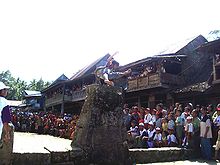Nias
| Nias | |
|---|---|
| Map of Nias | |
| Waters | Indian Ocean |
| Geographical location | 1 ° 5 ' N , 97 ° 35' E |
| length | 125 km |
| width | 40 km |
| surface | 4th 771 km² |
| Highest elevation | Gunung Lölömatua 886 m |
| Residents | 639.657 (2005) 134 inhabitants / km² |
| main place | Gunungsitoli |
| Topographic map | |
The island of Nias ( Indonesian Pulau Nias ) belongs to Indonesia and is located 125 km off the west coast of Sumatra in the Indian Ocean , a little north of the equator .
geography
The island is about 125 kilometers long and 40 kilometers wide. Administratively it belongs to the Sumatra Utara province . In the south are the Batu Islands , in the north Simeuluë and the Banyak Islands . To the west of Nias are the Hinako Islands . Nias is of volcanic origin, 4771 km² and has about 650,000 inhabitants.
The main town Gunungsitoli has about 74,000 inhabitants and is the island's administrative and economic center.
history
In 1669 the Dutch started trading on this island. Stone columns and stone coffins still bear witness to an ancient megalithic culture.
In the 19th century, many Niasser were enslaved . French priests first came to the island in the mid-19th century to convert their residents to Catholicism , but this failed because several priests were killed in a poison attack.
German missionaries from the Rheinische Missionsgesellschaft in Wuppertal were the next to venture to the island in 1865. They were more successful. Heinrich Sundermann from Ladbergen in the Tecklenburger Land near Osnabrück had been a missionary of the Rhenish Mission Society on Nias since 1875. He spent 35 years on Nias and studied the Niassic language intensively. By 1939 around 80% of the Niasser were Protestant. Many Niasser gave up their ethno-religious traditions such as headhunting and ancestor cult after Christianization. But numerous myths and stories are passed on in the narratives.
Special events
In 1942 65 survivors rescued themselves on the island after the sinking of the Van Imhoff .
A tsunami on December 26, 2004 , which was triggered by a strong earthquake of magnitude 9 not far north of the island, killed more than 300 people on the island.
Another large earthquake on March 28, 2005 with a magnitude of 8.7 followed by four meter high tsunami waves killed more than 600 people and injured over 3000. In the main town of Gunungsitoli, up to 80% of the buildings were destroyed. Gunungsitoli airport was also badly damaged.
Up to August 2005, over 650,000 euros in donations from Germany's “aid partner city” Münster and the surrounding area came to the island. In Ludwigsburg an initiative "Help for Nias," the Caritas and the district was jointly financed by the Social Service Agency Ludwigsburg, formed after the tsunami disaster. This aid was coordinated by the director of the Diakonisches Werk Ludwigsburg, Deacon Horst Krank, who had lived and worked with his family from 1971 to 1976 as an ecumenical employee of the local Protestant church on Nias. By December 2006, donations totaled over 225,000 euros.
population
The population consists predominantly of the indigenous Niassians who have lived on the island for more than a thousand years. Their language (Niassian Li Niha ) belongs to the large Austronesian language family , the closest related languages are the Mentawai and Batak languages in northern Sumatra . The Niasser were known and feared as headhunters in Southeast Asia and were shunned by the Europeans and Malays for a long time.
Today more than 85% of Niasser's are Christians (80% Protestant, 10% Catholic). Most of the immigrant Batak and Chinese people are also Christians. Muslims are the Javanese , Achinese and Minangkabau who make up less than 15% of the population of Nias.
literature
- Dominik Bonatz : The Megaliths in Nias. Nias Island Research Network, July 9, 2007
- Dominik Bonatz: Change in a megalithic culture in the 20th century (Nias / Indonesia). In: Anthropos , Volume 96, Issue 1, 2001, pp. 105-118
- Petra Gruber, Ulrike Herbig: Settlements and Housing on Nias Island: Adaption and Development. In: Semantic Scholar , 2006
- Johannes Maria Hämmerle: Nias - a world of its own. Legends, myths, traditions. Academia, Sankt Augustin 1999, ISBN 3-89665-147-1
- Johannes Maria Hämmerle: Stories and songs from the island of Nias in Indonesia. Harrassowitz, Wiesbaden 2008, ISBN 978-3-447-05812-4 .
- Johannes Maria Hämmerle: The heart of Hia speaks: The indigenous people on the island of Nias, Indonesia. Migration, founding villages, right-wing festivals and tiger fall. Academia Verlag, Sankt Augustin 2018
- Uwe Hummel, Tuhoni Telaumbanua: Cross and Adu: A Socio-Historical Study on the Encounter between Christianity and the Indigenous Culture on Nias and the Batu Islands, Indonesia (1865–1965) . Dissertation, Utrecht University, 2007. Published in: Mission , Volume 43. Boekencentrum, Zoetermeer 2007, ISBN 978-90-239-2216-2 .
- Jaap Art : Music in Nias. International Archives for Ethnography, Volume 38. EJ Brill, Leiden 1939.
- Martin Thomsen : A song of the dead from the island of Nias . KITLV, Royal Netherlands Institute of Southeast Asian and Caribbean Studies. Bijdragen tot de Taal-, Land- and Folklore . Deel 137, 4th Edition 1981, pp. 443-455. ( JSTOR 27863391 ).
- Paul Wirz : Nias the island of idols. Pictures from the western island of the island. Orell Füssli, Zurich 1929 (illustrated book).
Web links
Individual evidence
- ↑ The death ship . In: Der Spiegel . No. 52 , 1965 ( online - part 1). The death ship . In: Der Spiegel . No. 7 , 1966 ( online - part 2).






